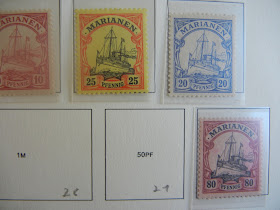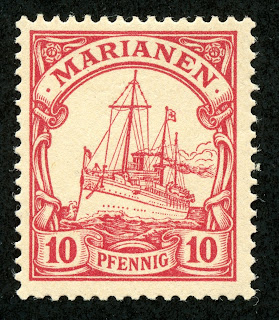1901 Scott 21 25pf orange & black/yellow
Kaiser's Yacht "Hohenzollern"
Quick HistoryThe Mariana Islands are an archipelago of 14 volcanic islands in the west Pacific Ocean north of Guam extending 1,500 miles (2,500 km) toward Japan. Saipon, Tinian, and Rota are inhabited currently, and the archipelago is now a Commonwealth of the United States.
The population was 44,000 in 1935, and the Capital is Saipon.
Map of Mariana Islands
But Spain had the original claim in 1667, naming them after the Spanish Queen Mariana of Austria. The Marianas- including Guam- were a Spanish colony, under the administration of the Philippines, until the Spanish-American War, when Guam was ceded to the United States. Then, in 1899, Spain sold the remaining islands to Germany.
Germany administered these islands as part of the German Protectorate of New Guinea. The population of the islands was only 2,600 at the time.
As part of WW I, Japan occupied the islands in 1914. They then became mandated territories to Japan under the League of Nations after WW I.
Guam was attacked from the Japanese held Marianas on December 8, 1941, the same day as the attack on Pearl Harbor. Guam was recaptured by the Americans in 1944. Saipan and Tinian were then occupied, and used extensively for round trip bomber missions to mainland Japan. The Enola Gay left Tinian's "North Field" for its atomic bomb mission to Hiroshima.
The classical era philatelic history, though, is of Spanish and German issues, beginning in 1899. Let's take a look...
1901 Scott 17 3pf brown
Into the Deep BlueThe 2011 Scott Classic Specialized catalogue has 6 major descriptive numbers for the 1899 handstamped (Spanish Dominion) Philippine issue, and 21 major numbers for the 1900-1919 German issues.
• The 1899 six King Alfonso XIII stamps of the Philippines, handstamped vertically, are major league CV expensive. CV $300+-$5000. And there are overprint forgeries. ;-) I will say no more about them, except I became aware of a philatelist on one of the internet forum groups that specializes in these stamps and covers. Nice!
• The German issues (21 major numbers) have a CV of $1+-$10+ for 16 stamps. Consequently, a representative collection can be acquired by the WW classical collector for a moderate outlay. Naturally, the unused stamps are significantly less expensive than genuine used copies.
A closer look at the stamps and issues
100 Centavos = 1 Peso
100 Pfenning = 1 Mark (1899)
The first six stamp issue of Germany in 1899 consists of the "Marianen" overprint at a 48 degree angle on stamps of Germany, 1889-90. These have a very high CV of $190+- $2,700+, and are given minor numbers in Scott.
The 1900 six stamp issue with 56 degree angle overprint have major numbers, and have a CV of $10+ for three stamps. Sadly, I have no examples at the moment. ( If I was specializing in Germany and Colonies, no doubt I would have some specimens. But as a WW intermediate classical collector, I am spread too thin ;-)
1901 Scott 20 20pf ultramarine
Kaiser's Yacht "Hohenzollern"
The issue I do have is the 1901 "Hohenzollern" design, which is essentially found for all German colonies. This 13 stamp issue comprises most of the affordable CV stamps for the Marianas, having a CV of $1+-$3+ for 10 stamps unused.
1901 Scott 23 40pf lake & black
The 25pf-80pf denominations are bi-colored printed, and certainly have visual appeal. The 1m-5m denominations are engraved, in larger horizontal format, and have a CV of $3+-$7+ for three stamps.
I should mention that there is also a 1916-19 3pf brown and a 5m slate & carmine with watermark "Lozenges" known, but these stamps were never placed in use.
Deep Blue
The 1901 set in Deep Blue
The Deep Blue album (Steiner) has two pages: One for the Spanish dominion 1899 issue, and one for the 1900-19 German issues. The uber-expensive minor number 1899 48 degree angle overprinted stamps are not given a formal space, thank goodness. ;-)
1901 Scott 18 5pf green
Big Blue
Big Blue '69, on two lines of one page, has a representative collection of 13 spaces, including three spaces for the overprinted 1900 issue. Nice! BTW, the page is found after "Macao", and before "Madagascar" in the '69.
Marianas Islands in Big Blue
Observations....
• Expensive stamps (CV $10+) include the Scott 11 and blank space choices Scott 12 & 13 for the overprinted "Marianen" issue of 1899 (actually 1900) for the 56 degree angle stamps.
• A nice selection of the 1900 (actually 1901) issue of 10 stamps is included.
• The Scott 30 3pf brown (wmk Lozenges) stamp issued in 1919, but never placed in use, is not given a space ( CV $1).
Checklist
1899
11, (12), (13),
1900-16
17,18,19,20,
21,22,23,24,25,26,
End
Comments
A) Expensive stamps ($10 threshold):
1900 Scott 11 3pf dark brown ($10+)
1900 (Scott 12) 5pf green ($10+)
1900 (Scott 13) 10pf carmine ($10+)
B) ( ) around a number indicates a blank space choice.
1901 Scott 19 10pf carmine
Out of the Blue
Here the history of the Marianas during WW II, even if the islands remain obscure for most, is of much more importance than the classical stamp issues of the Spanish Dominion and the German era.
And how many people realize that the present 50,000 inhabitants of the Northern Mariana Islands are U.S. citizens? ;-)
Note: Map, island pic appears to be in the public domain.
Comment?
Anatahan Island










Has any other nation used its ruler's yacht as extensively as the old German Empire did, I wonder? At least a break from endless ruler's heads. And it's a handsome yacht, but I doubt it ever made it to the Marianas.
ReplyDeleteThe Germans were so late into the colonial game that picking up little flyspecks in the Pacific really meant a lot to them and their mapmakers. I wonder if the cost-benefit analysis ever came close to being in Germany's favor or was it just spending for the prestige of a "Pacific Empire" no one ever visited?
Still enjoying each new Big Blue nation as its added to the blog. Always very well done.
"or was it just spending for the prestige of a "Pacific Empire" no one ever visited? "
ReplyDeleteThanks for the insightful comments, Drew.
Bismarck in fact did reverse course, not the least for the prestige factor...
"Bismarck had opposed colonial acquisitions, arguing that the burden of obtaining, maintaining and defending such possessions would outweigh any potential benefit. He felt that colonies did not pay for themselves, that the German bureaucratic system would not work well in the easy-going tropics, and that the diplomatic disputes colonies brought would distract Germany from its central interest, Europe itself.[53] However, in 1883–84 he suddenly reversed himself and overnight built a colonial empire in Africa and the South Pacific. Historians have debated exactly why he made this sudden and short-lived move.[54] He was aware that public opinion had started to demand colonies for reasons of German prestige."
Wikipedia
The yacht SMY Hohenzollern was scrapped in 1920 and dismantled in 1923 in Wilhelmshaven, not long after the Pacific colonies were purged from the fatherland. I tried, without luck, to find if any of her voyages were to the colonies that had her image on their stamps. Apparently she kept close to home, with one a venture across the Atlantic without the Kaiser.
ReplyDelete